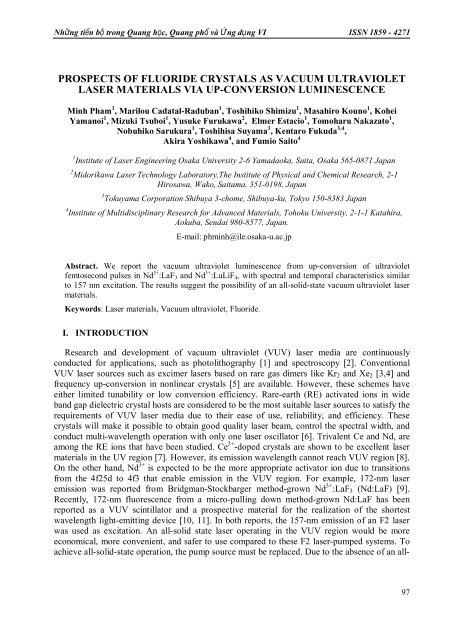Nhng tin b trong Quang hc, Quang ph và ng dng VI ISSN 1859 - 4271
Nhng tin b trong Quang hc, Quang ph và ng dng VI ISSN 1859 - 4271
Nhng tin b trong Quang hc, Quang ph và ng dng VI ISSN 1859 - 4271
You also want an ePaper? Increase the reach of your titles
YUMPU automatically turns print PDFs into web optimized ePapers that Google loves.
Nhữ<strong>ng</strong> tiến bộ <stro<strong>ng</strong>>tro<strong>ng</strong></stro<strong>ng</strong>> <stro<strong>ng</strong>>Qua<strong>ng</strong></stro<strong>ng</strong>> học, <stro<strong>ng</strong>>Qua<strong>ng</strong></stro<strong>ng</strong>> <stro<strong>ng</strong>>ph</stro<strong>ng</strong>>ổ và Ứ<strong>ng</strong> dụ<strong>ng</strong> <strong>VI</strong> <strong>ISSN</strong> <strong>1859</strong> - <strong>4271</strong>PROSPECTS OF FLUORIDE CRYSTALS AS VACUUM ULTRA<strong>VI</strong>OLETLASER MATERIALS <strong>VI</strong>A UP-CONVERSION LUMINESCENCEMinh Pham 1 , Marilou Cadatal-Raduban 1 , Toshihiko Shimizu 1 , Masahiro Kouno 1 , KoheiYamanoi 1 , Mizuki Tsuboi 1 , Yusuke Furukawa 2 , Elmer Estacio 1 , Tomoharu Nakazato 1 ,Nobuhiko Sarukura 1 , Toshihisa Suyama 3 , Kentaro Fukuda 3,4 ,Akira Yoshikawa 4 , and Fumio Saito 41 Institute of Laser E<strong>ng</strong>ineeri<strong>ng</strong> Osaka University 2-6 Yamadaoka, Suita, Osaka 565-0871 Japan2 Midorikawa Laser Technology Laboratory,The Institute of Physical and Chemical Research, 2-1Hirosawa, Wako, Saitama, 351-0198, Japan3 Tokuyama Corporation Shibuya 3-chome, Shibuya-ku, Tokyo 150-8383 Japan4 Institute of Multidisciplinary Research for Advanced Materials, Tohoku University, 2-1-1 Katahira,Aokuba, Sendai 980-8577, Japan.E-mail: <stro<strong>ng</strong>>ph</stro<strong>ng</strong>>minh@ile.osaka-u.ac.jpAbstract. We report the vacuum ultraviolet luminescence from up-conversion of ultravioletfemtosecond pulses in Nd 3+ :LaF 3 and Nd 3+ :LuLiF 4 , with spectral and temporal characteristics similarto 157 nm excitation. The results suggest the possibility of an all-solid-state vacuum ultraviolet lasermaterials.Keywords: Laser materials, Vacuum ultraviolet, Fluoride.I. INTRODUCTIONResearch and development of vacuum ultraviolet (VUV) laser media are con<s<stro<strong>ng</strong>>tro<strong>ng</strong></stro<strong>ng</strong>>>tin</s<stro<strong>ng</strong>>tro<strong>ng</strong></stro<strong>ng</strong>>>uouslyconducted for applications, such as <stro<strong>ng</strong>>ph</stro<strong>ng</strong>>otolithogra<stro<strong>ng</strong>>ph</stro<strong>ng</strong>>y [1] and spectroscopy [2]. ConventionalVUV laser sources such as excimer lasers based on rare gas dimers like Kr 2 and Xe 2 [3,4] andfrequency up-conversion in nonlinear crystals [5] are available. However, these schemes haveeither limited tunability or low conversion efficiency. Rare-earth (RE) activated ions in wideband gap dielectric crystal hosts are considered to be the most suitable laser sources to satisfy therequirements of VUV laser media due to their ease of use, reliability, and efficiency. Thesecrystals will make it possible to obtain good quality laser beam, control the spectral width, andconduct multi-wavele<strong>ng</strong>th operation with only one laser oscillator [6]. Trivalent Ce and Nd, areamo<strong>ng</strong> the RE ions that have been studied. Ce 3+ -doped crystals are shown to be excellent lasermaterials in the UV region [7]. However, its emission wavele<strong>ng</strong>th cannot reach VUV region [8].On the other hand, Nd 3+ is expected to be the more appropriate activator ion due to transitionsfrom the 4f25d to 4f3 that enable emission in the VUV region. For example, 172-nm laseremission was reported from Bridgman-Stockbarger method-grown Nd 3+ :LaF 3 (Nd:LaF) [9].Recently, 172-nm fluorescence from a micro-pulli<strong>ng</strong> down method-grown Nd:LaF has beenreported as a VUV scintillator and a prospective material for the realization of the shortestwavele<strong>ng</strong>th light-emit<s<stro<strong>ng</strong>>tro<strong>ng</strong></stro<strong>ng</strong>>>tin</s<stro<strong>ng</strong>>tro<strong>ng</strong></stro<strong>ng</strong>>>g device [10, 11]. In both reports, the 157-nm emission of an F2 laserwas used as excitation. An all-solid state laser opera<s<stro<strong>ng</strong>>tro<strong>ng</strong></stro<strong>ng</strong>>>tin</s<stro<strong>ng</strong>>tro<strong>ng</strong></stro<strong>ng</strong>>>g in the VUV region would be moreeconomical, more convenient, and safer to use compared to these F2 laser-pumped systems. Toachieve all-solid-state operation, the pump source must be replaced. Due to the absence of an all-97















